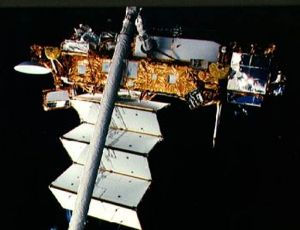
Home - Search - Browse - Alphabetic Index: 0- 1- 2- 3- 4- 5- 6- 7- 8- 9
A- B- C- D- E- F- G- H- I- J- K- L- M- N- O- P- Q- R- S- T- U- V- W- X- Y- Z
STS-48
 STS-48 Credit: NASA |
AKA: Discovery. Launched: 1991-09-12. Returned: 1991-09-18. Number crew: 5 . Duration: 5.35 days.
Payloads: Upper Atmosphere Research Satellite (UARS), Ascent Particle Monitor (APM)-03, Physiological and Anatomical Rodent Experiment (PARE)-01, Protein Crystal Growth (PCG)-ll-2, Middeck Zero-Gravity Dynamics, Experiment (MODE)-01, Investigations Into Polymer Membrane Processing (IPMP)-04, Cosmic Radiation Effects and Activation Monitor (CREAM-02), Radiation Monitoring Equipment (RME)-lll-06, Shuttle Activation Monitor (SAM)-03, Air Force Maui Optical Site (AMOS) Calibration Test.
Orbits of Earth: 81. Distance traveled: 3,530,369 km. Orbiter Liftoff Mass: 108,741 kg. Orbiter Mass at Landing: 87,318 kg. Payload to Orbit: 7,854 kg. Payload Returned: 1,314 kg. Landed at: Concrete runway 22 at Edwards Air Force Base, Cali. Landing Speed: 400 kph. Touchdown miss distance: 557 m. Landing Rollout: 2,679 m.
NASA Official Mission Narrative
Mission Name: STS-48 (43)
DISCOVERY (13)
Pad 39-A (42)
43rd Shuttle mission
13th Flight OV-103
5th Night landing
Crew:
John O. Creighton (3), Commander
Kenneth S. Reightler, Jr. (1), Pilot
James F. Buchli (4), Mission Specialist 1
Charles D. Gernar (2), Mission Specialist 2
Mark N. Brown (2), Mission Specialist 3
Milestones:
OPF - May 6, 1991
VAB - July 25, 1991
PAD - Aug. 12, 1991
Payload:
UARS,AMOS(1),APM,MODE,SAM,CREAM,PARE,PGC-II-2,IPMP
Mission Objectives:
Launch:
September 12, 1991, 7:11:04 p.m. EDT. Launch delayed 14 minutes by a faulty communication link between KSC and Mission Control in Houston. Launch Weight: 240,062 lbs.
Orbit:
Altitude: 313nm
Inclination: 57.0 degrees
Orbits: 81
Duration: 5 days, 8 hours, 27 minutes, 38 seconds.
Distance: 2,193,670 miles
Hardware:
SRB: BI-046
SRM: 360L018
ET : 42/LWT-35
MLP : 3
SSME-1: SN-2019
SSME-2: SN-2031
SSME-3: SN-2107
Landing:
September 18,1991, 12:38:42 a.m. PDT, Runway 22, Edwards AFB, Calif. Rollout distance: 9,513 feet. Rollout time: 50 seconds. Landed scheduled for KSC, but diverted to Edwards due to bad weather. Orbiter returned to KSC Sept. 26,1991. Landing Weight: 192,780 lbs.
Mission Highlights:
Primary payload, the Upper Atmosphere Research Satellite (UARS), deployed on the third day of the mission. During its planned 18-month mission, the l4,500-pound observatory will make the most extensive study ever conducted of the Earth's troposphere, the upper level of the planet's envelope of life- sustaining gases which also include the protective ozone layer. UARS has ten sensing and measuring devices: Cryogenic Limb Array Etalon Spectrometer (CLAES); Improved Stratospheric and Mesospheric Sounder (ISAMS); Microwave Limb Sounder (MLS); Halogen Occultation Experiment (HALOE); High Resolution Doppler Imager (HRDI); Wind Imaging Interferometer (WlNDII); Solar Ultraviolet Spectral Irradiance Monitor (SUSIM); Solar/Stellar Irra- diance Comparison Experiment (SOLSTICE); Particle Environ- ment Monitor (PEM) and Active Cavity Radiometer Irradiance Monitor (ACRIM II).
Secondary payloads were: Ascent Particle Monitor (APM); Middeck 0-Gravity Dynamics Experiment (MODE); Shuttle Activation Monitor (SAM); Cosmic Ray Effects and Activation Monitor (CREAM); Physiological and Anatomical Rodent Experiment (PARE); Protein Crystal Growth II-2 (PCG II-2); Investigations into Polymer Membrane Processing (IPMP); and the Air Force Maui Optical Site (AMOS) experiment.
More at: STS-48.
Family: Manned spaceflight. People: Brown, Mark, Buchli, Creighton, Gemar, Reightler. Country: USA. Spacecraft: Discovery. Projects: STS. Launch Sites: Cape Canaveral. Agency: NASA, NASA Houston.
1991 September 12 - . 23:11 GMT - . Launch Site: Cape Canaveral. Launch Complex: Cape Canaveral LC39A. Launch Platform: MLP3. LV Family: Shuttle. Launch Vehicle: Space Shuttle.
- STS-48 - .
Call Sign: Discovery. Crew: Brown, Mark,
Buchli,
Creighton,
Gemar,
Reightler.
Payload: Discovery F13 / UARS. Mass: 7,854 kg (17,315 lb). Nation: USA.
Related Persons: Brown, Mark,
Buchli,
Creighton,
Gemar,
Reightler.
Agency: NASA Houston.
Program: STS.
Class: Manned.
Type: Manned spaceplane. Flight: STS-48.
Spacecraft Bus: Shuttle.
Spacecraft: Discovery.
Duration: 5.35 days. Decay Date: 1991-09-19 . USAF Sat Cat: 21700 . COSPAR: 1991-063A. Apogee: 580 km (360 mi). Perigee: 575 km (357 mi). Inclination: 57.00 deg. Period: 96.20 min.
Manned five crew. Deployed UARS; conducted materials and biological research. Payloads: Upper Atmosphere Research Satellite (UARS), Ascent Particle Monitor (APM)-03, Physiological and Anatomical Rodent Experiment (PARE)-01, Protein Crystal Growth (PCG)-ll-2, Middeck Zero-Gravity Dynamics, Experiment (MODE)-01, Investigations Into Polymer Membrane Processing (IPMP)-04, Cosmic Radiation Effects and Activation Monitor (CREAM-02), Radiation Monitoring Equipment (RME)-lll-06, Shuttle Activation Monitor (SAM)-03, Air Force Maui Optical Site (AMOS) Calibration Test.
1991 September 13 - .
- STS-48 - Wakeup Song: Hound Dog - . Flight: STS-48. "Hound Dog" by Elvis Presley.
1991 September 14 - .
- STS-48 - Wakeup Song: Release Me - . Flight: STS-48. "Release Me" by Elvis Presley. In anticipation of deployment of Upper Atmosphere Research Satellite (UARS)..
1991 September 15 - .
- STS-48 - Wakeup Song: Bare Necessities - . Flight: STS-48. "Bare Necessities" from film"Jungle Book". Played for Ken Reightler's daughters who were in Mission Control Center viewing room..
1991 September 16 - .
- STS-48 - Wakeup Song: Are You Lonesome Tonight? - . Flight: STS-48. "Are You Lonesome Tonight?" by Elvis Presley. Chosen for its line"Are you sorry we drifted apart?" referring to Discovery's separation from its payload (UARS).
1991 September 17 - .
- STS-48 - Wakeup Song: Return to Sender - . Flight: STS-48. "Return to Sender" by Elvis Presley. In honor of expected landing. .
1991 September 18 - .
- Landing of STS-48 - . Return Crew: Brown, Mark, Buchli, Creighton, Gemar, Reightler. Nation: USA. Related Persons: Brown, Mark, Buchli, Creighton, Gemar, Reightler. Program: STS. Flight: STS-48. STS-48 landed at 07:38 GMT. .
Back to top of page
Home - Search - Browse - Alphabetic Index: 0- 1- 2- 3- 4- 5- 6- 7- 8- 9
A- B- C- D- E- F- G- H- I- J- K- L- M- N- O- P- Q- R- S- T- U- V- W- X- Y- Z
© 1997-2019 Mark Wade - Contact
© / Conditions for Use